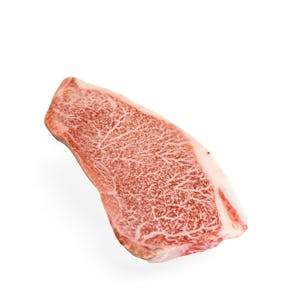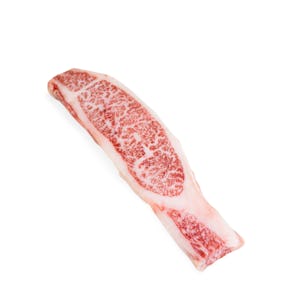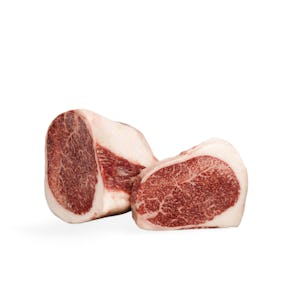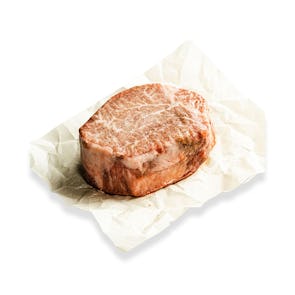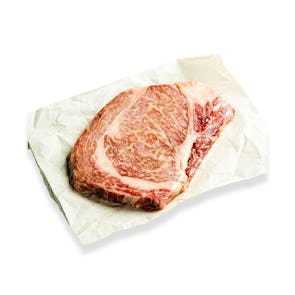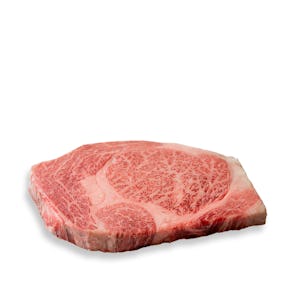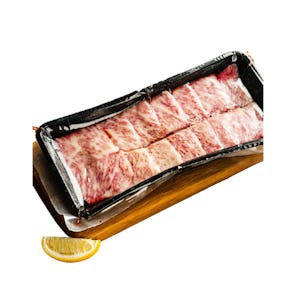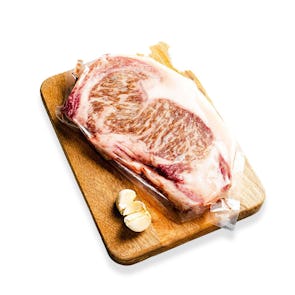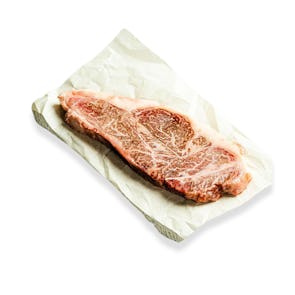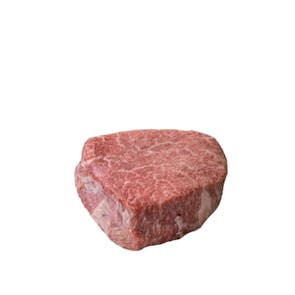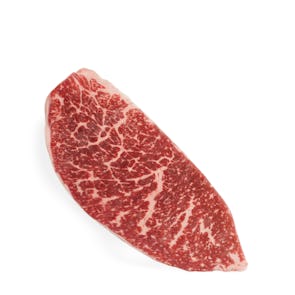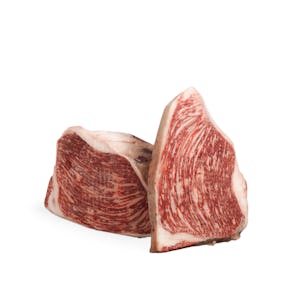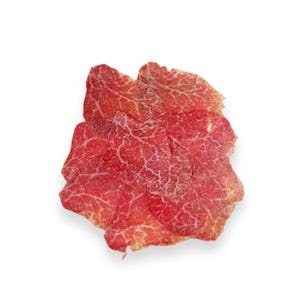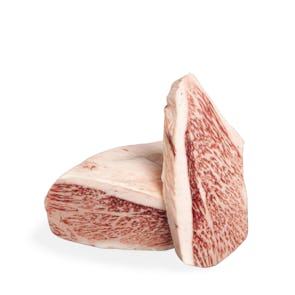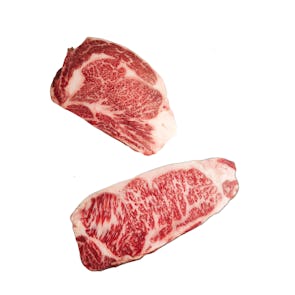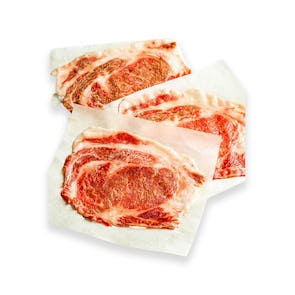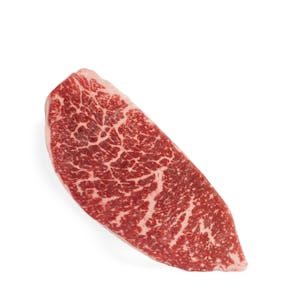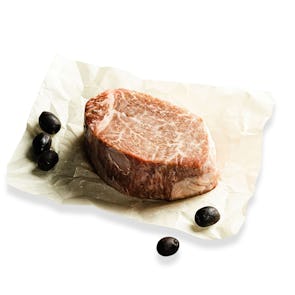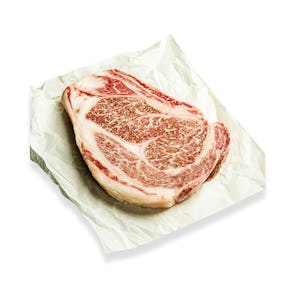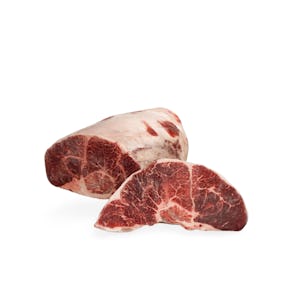- Categories
- Brands
- Origin
- Sort by: Recommended
Japanese Wagyu
Tender, marbled meat. Straight from Japan, the land of the rising sun. Wagyu, a delight
When it comes to the finest quality beef, nothing compares to Premium Japanese Wagyu. Known for its rich, marbled texture and incredible flavor, Japanese Wagyu beef is a true delicacy, prized by gourmets and food lovers around the world. This prime elusive cattle is considered as the best beef in the world for a reason. Add to cart and find out!
What makes Japanese Wagyu so special?
The secret to the superior quality of Japanese Wagyu lies in the care and attention given to the cattle. Raised on the finest pastures, Japanese Wagyu cattle are known for their superior quality and flavor. In fact, the quality of the beef is so highly regarded in Japan that there is a strict grading system in place to ensure only the finest cuts earn the coveted A5 rating - the highest possible score.
But the quality of Japanese Wagyu goes beyond just the grading system. The way the cattle are raised and cared for is also a key factor in the superior flavor and texture of the beef. For example, Japanese Wagyu cattle are often massaged and fed a special diet that includes a mixture of grains and beer, which helps to produce the rich, marbled texture that is so prized by gourmets.
But the true secret to the flavor and texture of Japanese Wagyu lies in its unique marbling. Unlike other types of beef, Japanese Wagyu has a high fat content, with delicate strands of fat interwoven throughout the meat. This gives the beef a rich, buttery texture that melts in your mouth, and a depth of flavor that is unmatched by other types of beef.
So if you’re looking for the finest quality beef, look no further than Japanese A5 Wagyu. Experience the true taste of Japan with this luxurious delicacy, and taste the difference for yourself.
In which prefectures is Wagyu beef produced?
One of the most famous prefectures for Japanese Wagyu beef is Kobe, located in the Hyogo prefecture. Kobe is famous for its high-quality beef, which is known for its delicate marbling and rich, buttery flavor. In fact, the Kobe Beef Marketing and Distribution Promotion Association is responsible for promoting and protecting the Kobe brand, and only the finest cuts of beef from Kobe are allowed to carry the Kobe label.
But Kobe is not the only prefecture that produces high-quality Japanese Wagyu beef. Other notable prefectures include Kagoshima, Miyazaki, and Oita, each of which has its own unique climate and landscape that helps to produce the high-quality beef that is so prized by gourmets.
So if you’re looking for the finest quality beef, look no further than Japanese A5 Wagyu. Experience the true taste of Japan with this luxurious delicacy, and taste the difference for yourself.
What is the difference between Japanese Wagyu and other Wagyus?
One of the key differences between Japanese Wagyu and other types of Wagyu is the way the cattle are raised and cared for. Japanese Wagyu cattle are raised on the finest pastures and are known for their superior quality and flavor. In contrast, other types of Wagyu are often raised in feedlots and may not receive the same level of care and attention.
Another difference is the grading system. In Japan, there is a strict grading system in place to ensure only the finest cuts of beef earn the coveted A5 rating - the highest possible score. This grading system is not used for other types of Wagyu, which means that the quality of the beef may vary.
So if you’re looking for the finest quality beef, look no further than Japanese A5 Wagyu.
How to cook Japanese Wagyu?
One of the best ways to cook Japanese Wagyu is by using the traditional Japanese method of yakiniku. This involves grilling the beef over a high heat, which helps to sear the meat and seal in the juices. The key is to not overcook the beef - it should be cooked for just a few seconds on each side, until it is nicely browned and still pink on the inside.
Another option is to try the sukiyaki method, which involves cooking the beef in a mixture of soy sauce, sugar, and mirin. The beef is cooked slowly over a low heat, which helps to tenderize the meat and give it a rich, savory flavor.
So if you’re looking to try Japanese Wagyu at home, these traditional cooking methods are a great way to experience the full flavor and texture of this luxurious delicacy.
How much Wagyu to serve per person?
The amount of Japanese Wagyu you serve per person will depend on a few factors, including the size of the cut and the type of meal you are serving. For a traditional Japanese yakiniku meal, where the beef is cooked and served in small pieces, a good rule of thumb is to allow for about 100-150 grams of beef per person.
If you are serving Japanese Wagyu as part of a larger meal, such as a sukiyaki hot pot, you may want to allow for a slightly larger portion. In this case, a good rule of thumb is to allow for about 200-250 grams of beef per person.
Remember, Japanese Wagyu is a delicacy, so a little goes a long way! Enjoy this luxurious ingredient in moderation, and savor the rich, buttery flavor of this exceptional beef.
What is the right cut for me?
Let’s take a closer look at the differences between some of the most popular cuts of Japanese Wagyu:
-
Wagyu Ribeye: Also known as the rib roast or prime rib, the ribeye is a rich, flavorful cut that is perfect for grilling or roasting. It has a good amount of fat marbling, which helps to keep the meat tender and juicy.
-
Wagyu Tenderloin: Also known as the filet mignon, the tenderloin is the most tender cut of beef. It is lean and has very little fat marbling, which makes it perfect for dishes that require a delicate touch, such as beef Wellington.
-
Wagyu Sirloin: The sirloin is a versatile cut that can be grilled, roasted, or sliced into steaks. It has a moderate amount of fat marbling and a robust, beefy flavor.
-
Wagyu Round: The round is a lean, economical cut that is often used for ground beef or braised dishes. It has very little fat marbling, so it can be a bit tougher than other cuts of beef.
-
Wagyu Trip Tip: The tri-tip is a triangular cut that is taken from the bottom sirloin. It is often grilled or roasted, and has a good amount of fat marbling and a robust, beefy flavor.
-
Wagyu Picanha: Also known as the rump cap or coulotte, the picanha is a popular cut in Brazil. It is often grilled or roasted, and has a good amount of fat marbling and a rich, beefy flavor.
So whether you’re looking for a rich, flavorful cut for grilling or a lean, delicate cut for a special occasion, there is a Japanese Wagyu cut to suit your needs. Bon appétit!
What can I cook with Wagyu beef?
Japanese Wagyu beef is known for its rich, marbled texture and incredible flavor, making it a favorite among foodies and gourmets alike. But with so many delicious cuts to choose from, it can be difficult to know which one is best for your recipe.
In our opinion, the best recipe for Japanese Wagyu beef is a simple, classic dish that showcases the incredible flavor and texture of the beef. For example, a perfectly seared Japanese Wagyu ribeye, served with a simple side of roasted vegetables and a red wine jus, is a dish that will truly make your taste buds sing.
Or, if you’re feeling adventurous, try making a Japanese Wagyu beef tartare, using the finest cuts of Japanese Wagyu and mixing in a few finely chopped herbs and a touch of truffle oil. Serve it on toast points or with a side of crispy frites, and you have a truly indulgent and unforgettable meal.
Some other ideas that can be used with the cheaper cuts:
-
Japanese Wagyu beef burgers: Mix ground Japanese Wagyu beef with a few finely chopped herbs and seasonings, and shape it into burger patties. Grill or sear the burgers until cooked to your desired level of doneness, and serve them on toasted buns with all your favorite toppings, such as lettuce, tomato, onion, cheese, and a creamy sauce.
-
Japanese Wagyu beef stir fry: Cut Japanese Wagyu beef into thin strips, and stir fry it with a mixture of your favorite vegetables, such as bell peppers, onions, mushrooms, and broccoli. Season the stir fry with soy sauce, garlic, and ginger, and serve it over a bed of steamed rice or noodles.
-
Japanese Wagyu beef kebabs: Thread cubes of Japanese Wagyu beef onto skewers, along with a mixture of vegetables such as bell peppers, onions, and cherry tomatoes. Grill the kebabs over high heat, basting them with a marinade of your choice, until the beef is cooked to your desired level of doneness. Serve the kebabs with a side of rice or vegetables, and a tangy dipping sauce.
-
Japanese Wagyu beef tacos: Mix diced Japanese Wagyu beef with a blend of Mexican spices, such as cumin, chili powder, and oregano. Cook the beef in a skillet until browned and fragrant, and serve it in warmed corn tortillas, topped with all your favorite taco fixings, such as lettuce, tomato, onion, cheese, salsa, and guacamole.
-
Japanese Wagyu beef salad: Slice Japanese Wagyu beef into thin strips, and sear it in a hot skillet until cooked to your desired level of doneness. Toss the beef with a mixture of your favorite salad greens, such as arugula, spinach, and romaine, along with a variety of colorful vegetables, such as cherry tomatoes, sliced cucumber, and shredded carrots. Top the salad with a simple vinaigrette dressing, and enjoy the delicious combination of flavors and textures.
-
Japanese Wagyu beef noodles: Cook your favorite type of noodles, such as udon or soba, according to the package instructions. In a separate skillet, cook diced Japanese Wagyu beef in a mixture of soy sauce, mirin, and sake until it is browned and fragrant. Serve the noodles in bowls, topped with the Japanese Wagyu beef and a drizzle of the cooking sauce. Garnish the noodles with green onions and sesame seeds, and enjoy the delicious, comforting flavors of this simple but satisfying dish.
No matter how you choose to prepare it, Japanese Wagyu beef is a culinary treasure that should be savored and enjoyed to the fullest. Bon appétit!


